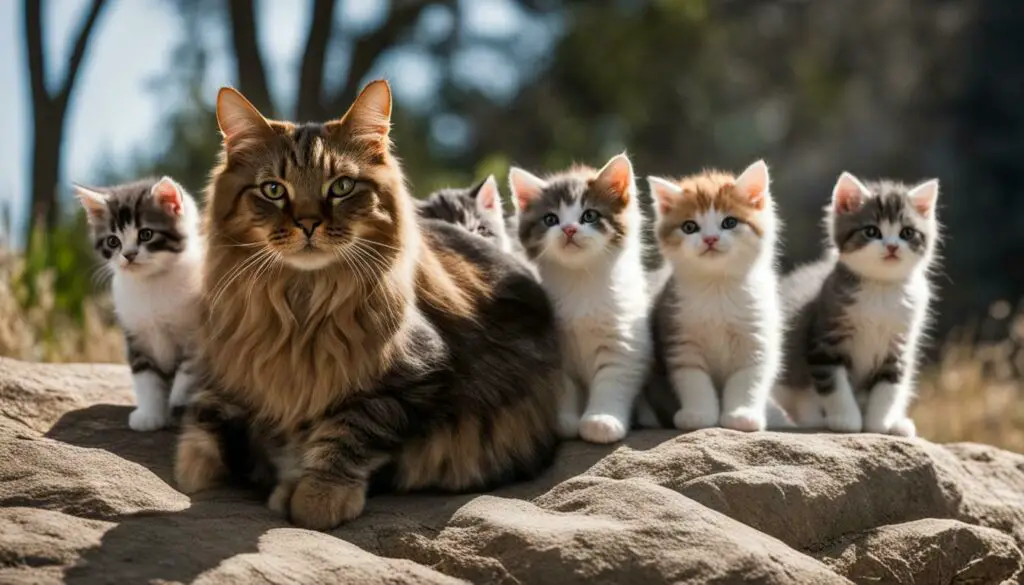Cats killing kittens is a disturbing behavior that requires a deeper understanding for effective prevention.
Male cats may kill kittens, either their own or those belonging to another cat, for several reasons. In social groups, dominated by females, males may kill kittens fathered by another male in order to ensure the survival of their own genes. Scent markings and territorial instincts play a role in identifying which kittens belong to a rival male. Some tomcats also kill kittens to establish their own lineage when taking over a territory. Neutered tomcats are generally more benevolent towards kittens. Female cats may also kill kittens due to hunting instincts, hormonal imbalances, perceived abnormalities or illnesses in the kittens, or in response to stress or disturbances in the nest. Protective behavior by queens may vary and depend on factors such as physical condition, presence, and size. Male cats may exhibit either protective or predatory behavior towards kittens, depending on their relationship to the kittens. Predatory behavior is more likely to occur in unneutered males and can be triggered by territorial instincts and perceived threats. Signs to look out for include stalking, growling, aggression towards other cats or attempts to separate kittens from their mother. Neutering male cats and providing separate living areas and enough resources can help prevent harm to kittens.
Key Takeaways:
- Understanding the reasons behind cats killing kittens, including territorial instincts and survival of genes
- Factors contributing to feline infanticide, such as scent markings and the establishment of territory
- Female cat behavior, including hunting instincts and protective behavior, that may lead to the killing of kittens
- Identifying signs of aggression and threats to kittens, such as stalking and growling
- Prevention methods, including neutering male cats, providing separate living areas, and ensuring sufficient resources
The Reasons Behind Cats Killing Kittens
Male and female cats may kill kittens for various reasons, driven by instincts and their role within social groups. Understanding these reasons can help us take appropriate measures to prevent such behavior. Male cats, in particular, may engage in feline infanticide to ensure the survival of their own genes. In social groups dominated by females, males may kill kittens fathered by another male to establish their own lineage. Scent markings and territorial instincts play a role in identifying which kittens belong to a rival male. Additionally, male cats may kill kittens when taking over a territory, solidifying their dominance. However, neutered tomcats are generally more benevolent towards kittens, as the absence of hormones reduces aggressive tendencies.
Female cats may also exhibit aggression towards kittens for various reasons. Hunting instincts can trigger predatory behavior, especially in unneutered females. Hormonal imbalances can also affect a female cat’s behavior towards kittens. Moreover, perceived abnormalities or illnesses in the kittens can lead to aggressive reactions from the mother cat. Stress or disturbances in the nest environment can also trigger defensive behaviors, where the queen perceives a threat to herself or her offspring. It is important to note that the response of female cats towards kittens can vary depending on factors such as their physical condition, the presence of other cats, and the size of the litter.
Protective behavior by male cats towards kittens can manifest in different ways. Some males exhibit protective behavior, acting as father figures or defenders of the young. However, other males may display predatory behavior, especially if they perceive the kittens as threats to their territory or resources. Signs of aggression and threats from male cats towards kittens include stalking, growling, aggression towards other cats, and attempts to separate the kittens from their mother. Identifying these signs early on can help intervene and protect the kittens from potential harm.
In order to prevent cats from harming kittens, it is crucial to consider preventive measures such as neutering male cats. Neutering can help reduce cat aggression, territorial behavior, and the likelihood of feline infanticide. Providing separate living areas for cats, ensuring sufficient resources for each cat, and proper cat training and socialization can also contribute to a safe and harmonious environment for both adult cats and kittens.
Male Cats and Feline Infanticide
Male cats may engage in feline infanticide to ensure the survival of their own genes and establish their dominance within a territory. This behavior is commonly observed in social groups where dominant females rule and males strive to propagate their own lineage. Scent markings and territorial instincts play a significant role in identifying which kittens belong to a rival male, prompting some males to eliminate their competitors’ offspring. Additionally, male cats may also kill kittens when taking over a territory, asserting their dominance and securing their own genetic legacy.
However, it is important to note that neutering can have a positive impact on reducing feline infanticide. Neutered tomcats are generally more benevolent towards kittens and are less driven by territorial instincts and the need to establish dominance through aggression. By eliminating the urge to reproduce, neutering helps to create a more harmonious environment within social groups and reduces the likelihood of male cats engaging in harmful behavior towards kittens.
To summarize, male cats may exhibit feline infanticide as a means to ensure the survival of their own genes and establish their dominance within a territory. However, neutering male cats can significantly mitigate this behavior, promoting a safer and more peaceful coexistence between cats and their offspring.
| Fact | Male Cats and Feline Infanticide |
|---|---|
| Behavior | Engaging in feline infanticide |
| Reason | To ensure survival of their own genes and establish dominance within a territory |
| Factors | Scent markings, territorial instincts, and rivalry with other males |
| Prevention | Neutering male cats |
Female Cats and Killing Kittens
Female cats may exhibit aggressive behavior towards kittens due to a range of factors, including their innate hunting instincts and hormonal imbalances. It is important to understand these reasons in order to prevent harm to the kittens and promote their safety and well-being.
Hunting instincts play a significant role in a female cat’s behavior towards her kittens. These instincts are deeply ingrained and can manifest as aggressive behavior, especially when the kittens are perceived as prey. The mother cat may unintentionally harm or even kill her own kittens during play or in an attempt to teach them hunting skills. This behavior is influenced by the instincts of survival and ensuring the offspring’s ability to fend for themselves in the future.
Hormonal imbalances can also contribute to aggressive behavior in female cats towards their kittens. Fluctuations in hormone levels, particularly during pregnancy and shortly after giving birth, can affect the mother’s behavior and temperament. These imbalances can lead to increased protectiveness and aggression towards perceived threats or abnormalities in the kittens.
Stress and disturbances in the nest can further exacerbate a female cat’s aggression towards her kittens. Changes in the environment, such as the presence of unfamiliar animals or noise disruptions, can cause the mother to become anxious or agitated. This, in turn, may trigger defensive behaviors and aggression towards the kittens.
Understanding these factors and providing a safe and stress-free environment for the mother cat and her kittens is crucial in minimizing the risk of harm. Ensuring that the mother cat is in good physical condition, providing adequate resources, and offering support and socialization can help alleviate aggression and promote a healthy relationship between the mother and her kittens.
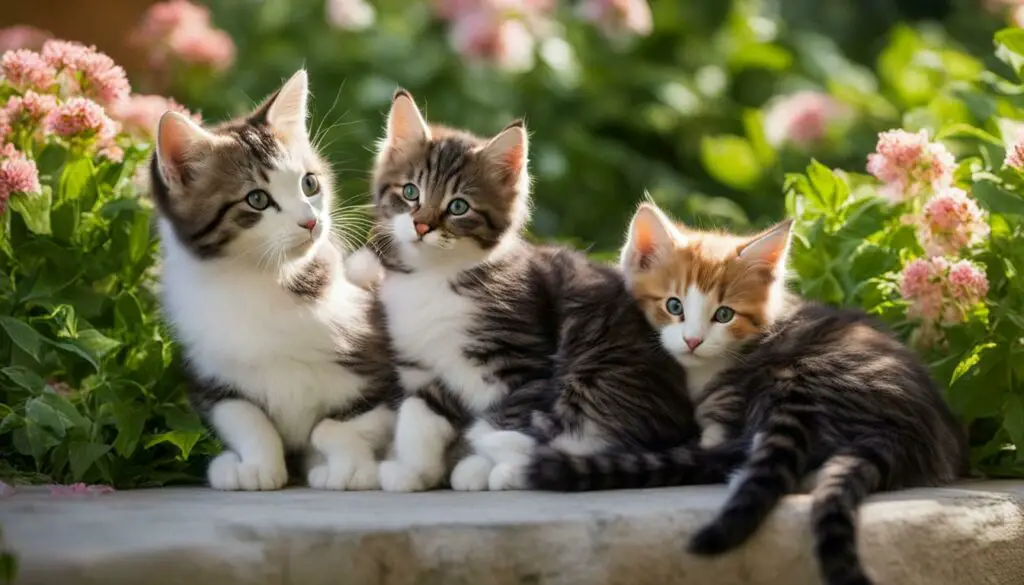
Signs of Aggression and Threats to Kittens
It is crucial to recognize the signs of aggression and threats that cats may exhibit towards kittens, such as stalking, growling, and attempts to separate them from their mother. These behaviors can be alarming, especially for first-time cat owners or those with a new litter of kittens. When a cat stalks or follows the kittens closely, it may be a sign of predatory behavior or territorial instincts. Growling is another indicator of aggression, as the cat is expressing its discomfort or assertiveness towards the kittens. In some cases, a cat may even try to separate the kittens from their mother, showing signs of dominance or territorial behavior.
Unneutered males are more likely to display aggressive behavior towards kittens, driven by their territorial instincts and perceived threats. They may see the presence of unfamiliar kittens as a challenge to their dominance or as potential rivals. This is why it is essential to observe and monitor interactions between cats and kittens, especially in multi-cat households or when introducing new cats.
Creating a safe and stress-free environment for the kittens is important to minimize the risk of aggression from other cats. Providing separate living areas for each cat can help reduce territorial disputes and allow the mother cat to care for her kittens without interference. Additionally, ensuring that each cat has sufficient resources, such as food, water, litter boxes, and resting areas, can prevent competition and aggression.
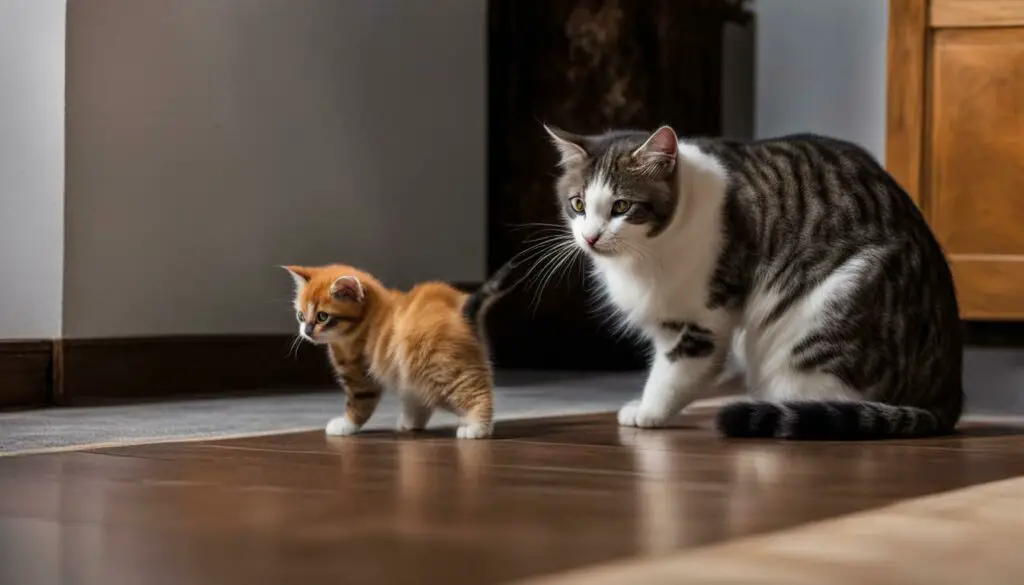
Preventing harm to kittens requires understanding and addressing the underlying causes of aggression. Neutering male cats can significantly decrease aggressive behavior, as it reduces their territorial instincts and minimizes the chances of them fathering and defending their own kittens. It is also important to provide appropriate cat socialization and training to promote positive behavior and minimize aggression towards kittens.
By being aware of the signs of aggression and threats that cats may exhibit towards kittens, owners can take proactive measures to prevent harm. Recognizing these behaviors early on allows for swift intervention and a safer environment for both the kittens and their mother.
Prevention Methods: Neutering Male Cats
Neutering male cats is a key prevention method to reduce cat aggression and address behavior problems that can lead to harm towards kittens. By removing the source of testosterone, neutering helps to curb territorial behavior and minimize the risk of feline infanticide. Tomcats that have been neutered are generally more benevolent towards kittens and less likely to exhibit aggressive or predatory behavior.
In addition to reducing aggression, neutering male cats can also have positive effects on their overall behavior. It helps to prevent roaming, spraying, and marking territory with urine, which can contribute to a more harmonious environment for both cats and kittens. Neutered males are less likely to engage in dominance battles or territorial disputes, reducing the potential for harm to kittens in the process.
It is important to note that neutering should be done by a licensed veterinarian, following proper medical protocols. The procedure involves the removal of the testes, usually through a small incision in the scrotum. It is a safe and routine surgery that can be performed on cats as young as eight weeks old. Neutering not only helps prevent cats from harming kittens but also contributes to population control and reduces the number of homeless cats in our communities.
| Benefits of Neutering Male Cats | Prevention Methods |
|---|---|
| Reduces cat aggression | Neutering male cats |
| Addresses behavior problems | Providing separate living areas |
| Curbs territorial behavior | Ensuring sufficient resources |
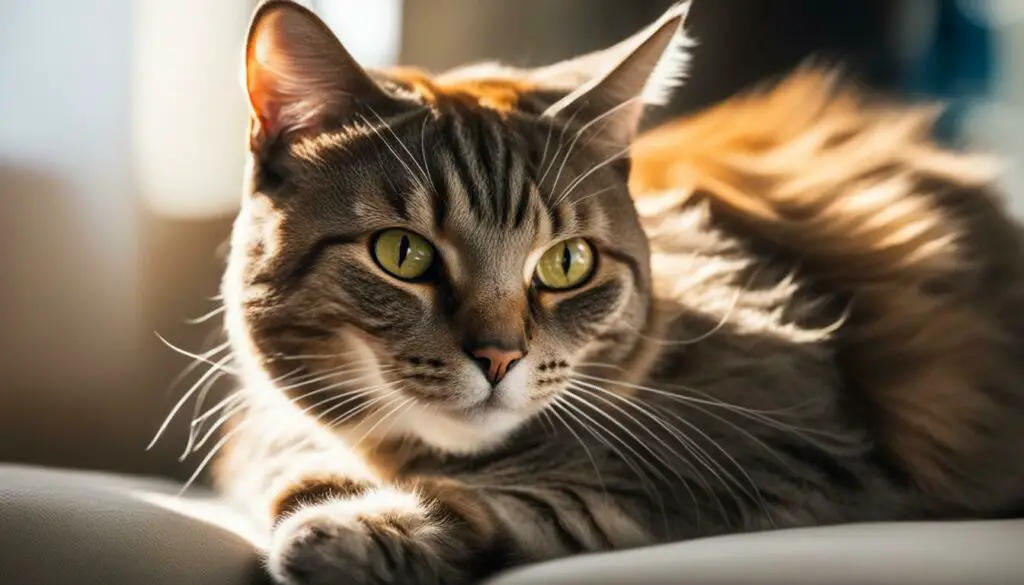
Neutering male cats is a crucial step in preventing cat aggression and ensuring the safety of kittens. By neutralizing the territorial instincts and reducing aggression, neutering helps create a harmonious environment for cats and kittens alike. It is a responsible choice that benefits both individual cats and the overall cat population.
Providing Separate Living Areas
Creating separate living areas for cats is essential to prevent potential harm to kittens, especially related to territorial behavior. Cats are naturally territorial animals, and conflicts can arise when multiple cats are forced to share the same space. By designating specific areas for each cat, you can minimize the chances of aggression and ensure the safety of the kittens.
To establish separate living areas, consider the following tips:
- Provide individual sleeping spaces: Each cat should have their own cozy spot where they can retreat and feel safe. This could be a separate bed, blanket, or even a designated room for each cat.
- Set up multiple feeding stations: Cats can become possessive over their food, leading to territorial disputes. To avoid this, provide multiple feeding stations throughout your home, ensuring that each cat has their own dedicated area.
- Create vertical spaces: Cats love to climb and perch in high places, and providing vertical spaces can help create a sense of territory for each cat. Consider adding cat trees, shelves, or wall-mounted perches to maximize vertical space.
Remember, when introducing separate living areas, it is important to allow each cat to gradually acclimate to their new space. This can be done by initially confining each cat to their designated area and gradually allowing supervised interactions.
Table: Examples of Separate Living Areas
| Cat | Living Area |
|---|---|
| Fluffy | Bedroom with separate litter box, bed, and food station |
| Whiskers | Living room with vertical spaces, scratching post, and designated feeding area |
| Simba | Office with a cozy cat bed, toys, and a separate litter box |
By providing separate living areas, you create a harmonious environment where each cat has their own space and can live without the stress of territorial conflicts. This not only ensures the safety of the kittens but also promotes overall well-being and happiness for all feline family members.

Ensuring Sufficient Resources
Ensuring sufficient resources for each cat is vital in preventing territorial behavior and aggression that could lead to harm towards kittens. Cats are naturally territorial animals, and when resources such as food, water, and space are limited, they may become more aggressive towards other cats, including kittens. By providing an adequate number of resources, you can help alleviate any potential competition or stress among the cats in your household, promoting a harmonious environment for both adult cats and kittens.
To ensure each cat has access to sufficient resources, consider the following:
- Multiple feeding stations: Set up separate feeding areas to prevent cats from competing for food. Each station should have its own bowls and be placed in different locations to give each cat a sense of ownership over their feeding space.
- Plenty of water sources: Provide multiple water bowls or install cat water fountains throughout your home to ensure each cat has access to fresh water at all times.
- Ample litter boxes: Cats are naturally clean animals and prefer to have their own designated bathroom areas. Aim for at least one litter box per cat, plus an extra one, and place them in different locations to prevent overcrowding and reduce the likelihood of territorial marking.
- Individual resting spots: Cats appreciate having their own cozy spots to relax and unwind. Provide multiple cat beds, perches, or hideaways so that each cat can have their own personal space where they feel safe and secure.
By providing sufficient resources, you can help reduce the likelihood of territorial conflicts and minimize the chances of aggression towards kittens. It’s important to monitor the cats’ behavior during feeding, ensure litter boxes are regularly cleaned, and create a peaceful environment that promotes positive interactions between all cats in your household.
| Resource | Quantity | Placement |
|---|---|---|
| Food Bowls | One per cat | Different locations |
| Water Sources | Multiple | Throughout the house |
| Litter Boxes | One per cat + 1 extra | Different locations |
| Resting Spots | Multiple | Various areas |

Providing sufficient resources for each cat is essential for maintaining a peaceful and harmonious household environment. By ensuring an ample number of feeding stations, water sources, litter boxes, and resting spots, you can minimize territorial behavior and reduce the likelihood of aggression towards kittens. Remember to monitor the cats’ interactions and make adjustments as needed to promote a safe and stress-free environment for everyone.
Training and Socializing Cats
Training and socializing cats play a crucial role in preventing potential harm to kittens by addressing territorial behavior and reducing cat aggression. By teaching cats appropriate behaviors and providing them with opportunities for positive social interactions, we can create a harmonious environment where kittens can thrive.
One effective training method is positive reinforcement, which involves rewarding cats for exhibiting desired behaviors. This can be done through treats, praise, or playtime. For example, when a cat interacts peacefully with kittens, they can be rewarded with a tasty treat or a favorite toy. This positive association helps to reinforce the behavior and encourages cats to repeat it.
Socialization is another important aspect of training. Exposing cats to different environments, people, and animals from a young age helps them become more adaptable and less prone to aggression. Gradually introducing cats to new experiences and situations can also help them learn how to cope with stress and reduce the likelihood of aggressive behavior towards kittens.
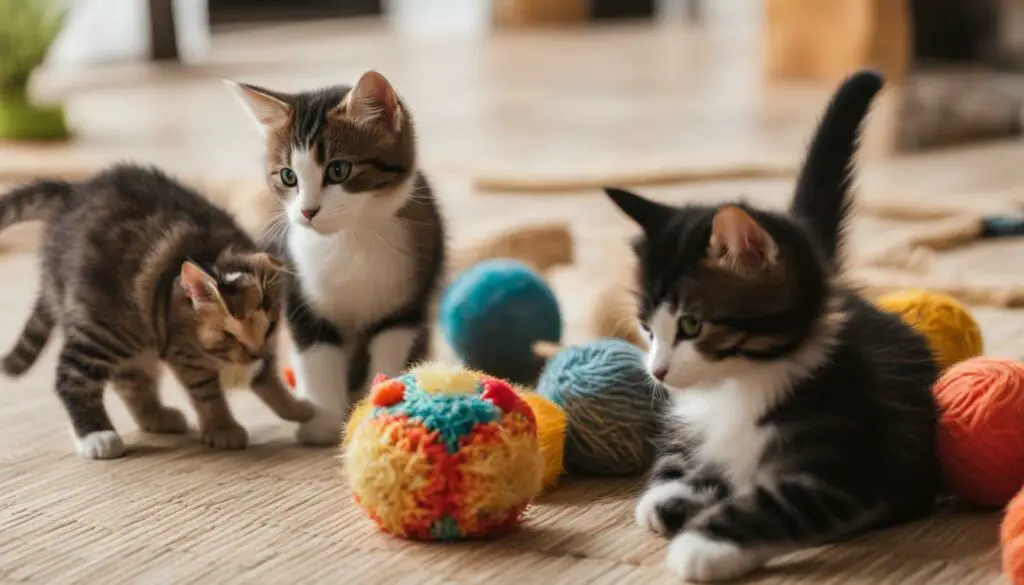
Creating a safe and stimulating environment is essential for training and socializing cats. Providing scratching posts, interactive toys, and vertical spaces allows cats to engage in natural behaviors and release pent-up energy. This can help prevent territorial disputes and redirect their focus away from potentially harmful interactions with kittens.
In summary, training and socializing cats are vital in preventing cats from harming kittens. Positive reinforcement techniques and early exposure to different stimuli can help cats develop appropriate behaviors and reduce aggression. By investing time and effort into training and socialization, we can create a safe and nurturing environment where kittens can grow and thrive alongside their feline companions.
Table 1: Tips for Training and Socializing Cats
| Tips | Description |
|---|---|
| Use positive reinforcement | Reward desired behaviors with treats, praise, or playtime |
| Expose cats to different environments | Gradually introduce them to new experiences and situations |
| Provide stimulating environments | Offer scratching posts, interactive toys, and vertical spaces |
Creating a Safe Environment for Kittens
Creating a safe environment for kittens is essential to protect them from potential harm caused by territorial behavior exhibited by other cats. As kittens are vulnerable and still developing, it is important to take precautions to ensure their safety and well-being. Here are some tips to help you create a safe space for your kittens:
- Provide a separate living area: Set up a designated space for the kittens where they can stay away from other cats. This can be a separate room or a cozy corner in your home that is inaccessible to other feline household members. Make sure this area is comfortable, warm, and filled with essentials such as food, water, bedding, and litter boxes.
- Implement territorial scent control: Cats rely heavily on scent markings to establish their territories. To prevent potential clashes and aggression, it is important to keep the kitten’s living area and belongings separate from other cats. Use separate litter boxes and provide individual bedding and toys for each cat to reduce territorial disputes.
- Ensure ample resources: Providing sufficient resources is essential to minimize competition and potential conflicts between cats. Make sure to have an adequate number of food and water stations, litter boxes, and hiding spots for each cat. This will help alleviate any stress or tension that can lead to territorial behavior.
- Promote positive socialization: Proper socialization of kittens is crucial for their development. Gradually introduce them to other cats in a controlled and supervised manner, allowing them to become familiar with each other’s scents and presence. Positive interactions can help reduce the likelihood of aggression and ensure a more harmonious coexistence.
By implementing these measures, you can create a safe and secure environment for your kittens, minimizing the risks associated with territorial behavior and promoting their overall well-being. Remember, providing a stress-free and nurturing space is essential for their healthy growth and development.
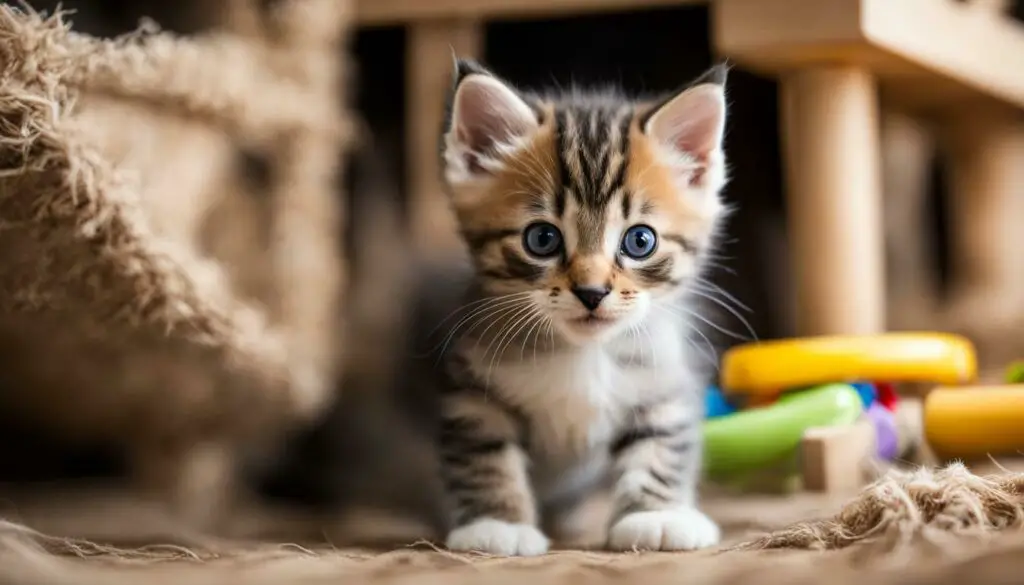
Understanding Cat Territorial Behavior
Understanding cat territorial behavior, including scent markings, is crucial in preventing potential harm towards kittens. Cats are highly territorial animals, and they use scent markings to establish and defend their territories. Scent marking involves rubbing their bodies against objects or spraying urine to leave a scent that signals ownership.
Scent markings play a significant role in identifying which kittens belong to a rival male. Male cats may kill kittens fathered by another male in order to ensure the survival of their own genes. By eliminating the offspring of a rival, they increase the chances of passing on their own genetic material to future generations.
To further establish their dominance, some tomcats engage in infanticide when taking over a territory. By eliminating any existing kittens, they can then mate with the queen and father their own offspring. However, it’s important to note that neutered tomcats are generally more benevolent towards kittens and are less likely to display aggressive behaviors.
The Role of Scent Markings
Scent markings not only help cats establish territorial boundaries but also facilitate communication between cats. They contain information about the cat’s age, sex, reproductive status, and health, allowing other cats to determine if they pose a threat or if they are potential mates. By understanding how scent markings work, cat owners can take steps to prevent aggressive behaviors towards kittens.
| Scent Marking Behavior | Meaning |
|---|---|
| Rubbing against objects | Claiming ownership and marking territory |
| Urine spraying | Signaling reproductive availability and marking territory |
| Scratching | Marking territory and sharpening claws |
By providing cats with sufficient resources, such as separate living areas and enough food, water, and litter boxes, owners can minimize territorial conflicts and reduce the likelihood of aggressive behaviors towards kittens. Additionally, neutering male cats and gradually introducing them to new kittens can help prevent potential harm, as neutered males are less likely to display aggressive behaviors.

Understanding cat territorial behavior is crucial for cat owners to create a harmonious environment for both adult cats and kittens. By recognizing the importance of scent markings and taking appropriate measures to prevent territorial conflicts, owners can ensure the safety and well-being of their feline companions.
Dealing with Aggressive Cats
Dealing with aggressive cats is essential to prevent potential harm towards kittens and address issues related to territorial behavior and cat aggression. Aggression in cats can stem from various factors, including fear, stress, or a desire to establish dominance. Understanding the underlying causes can help in finding effective solutions to manage and modify their behavior.
One approach to dealing with aggressive cats is to provide them with appropriate outlets for their energy and instincts. Engaging them in interactive play sessions with toys that mimic hunting can help redirect their aggression in a healthy way. Additionally, creating a stimulating environment with scratching posts, climbing trees, and puzzle toys can alleviate boredom and minimize aggressive behavior.
It is crucial to establish a routine and consistent boundaries for aggressive cats. Setting clear rules and boundaries, such as not allowing them on certain furniture or using positive reinforcement techniques to reward good behavior, can help in managing their aggression. Implementing a reward-based training program can gradually shape their behavior and encourage positive interactions.
Seeking professional help from a veterinarian or animal behaviorist is recommended for cases of severe aggression or when the safety of kittens is at risk. They can provide expert guidance and develop a customized behavior modification plan that addresses the specific needs of your cat. Remember, patience, consistency, and understanding are key when dealing with aggressive cats.
Conclusion
By understanding the behavior of cats killing kittens and implementing effective prevention methods, we can ensure the safety and well-being of both adult cats and kittens. Male cats may kill kittens for various reasons, such as establishing their own lineage or ensuring the survival of their own genes. Scent markings and territorial instincts play a significant role in identifying rival males and their kittens. Neutered tomcats generally exhibit more benevolent behavior towards kittens, reducing the risk of harm.
Female cats may also kill kittens due to hunting instincts, hormonal imbalances, or in response to stress or disturbances in the nest. Protective behavior by queens may vary depending on various factors, such as physical condition, the presence of perceived abnormalities or illnesses in the kittens, and the size of the litter. It is essential to recognize signs of aggression and threats towards kittens, including stalking, growling, aggression towards other cats, or attempts to separate kittens from their mother.
To prevent harm to kittens, neutering male cats is highly recommended. Providing separate living areas and sufficient resources for each cat can also help minimize aggression and territorial behavior. Training and socializing cats, using positive reinforcement techniques, can aid in curbing aggressive behavior. Creating a safe environment for kittens, considering their safety and protecting them from territorial conflicts, is crucial. Understanding cat territorial behavior, particularly scent markings, can also play a vital role in preventing cats from harming kittens.
By taking these preventive measures and being proactive in addressing cat aggression and behavior problems, we can create a harmonious environment where cats and kittens can thrive together, ensuring their safety and well-being.
FAQ
Why do male cats kill kittens?
Male cats may kill kittens, either their own or those belonging to another cat, for several reasons. This behavior is driven by factors such as the survival of their own genes, scent markings, and territorial instincts.
Why do female cats kill kittens?
Female cats may kill kittens due to hunting instincts, hormonal imbalances, perceived abnormalities or illnesses in the kittens, or in response to stress or disturbances in the nest. The protective behavior of queens may also vary depending on factors such as their physical condition.
What are the signs of aggression and threats to kittens?
Signs to look out for include stalking, growling, aggression towards other cats, or attempts to separate kittens from their mother. These behaviors are more likely to occur in unneutered males and can be triggered by territorial instincts and perceived threats.
How can I prevent male cats from harming kittens?
Neutering male cats is an effective prevention method. Neutered tomcats are generally more benevolent towards kittens and less likely to exhibit predatory behavior or aggression.
How can I prevent female cats from harming kittens?
Providing a safe and stress-free environment for the mother cat and her kittens is crucial in preventing harmful behavior. Additionally, addressing any hormonal imbalances or illnesses and ensuring proper cat socialization can help reduce the risk of aggression towards kittens.
What can I do to create a safe environment for kittens?
It is important to provide separate living areas and sufficient resources for each cat to avoid territorial conflicts. Additionally, training and socializing cats can help in preventing them from harming kittens.
How can I deal with aggressive cats?
If you have an aggressive cat, it is essential to address the underlying causes of the aggression, such as territorial behavior or hormonal imbalances. Consulting with a veterinarian or a professional cat behaviorist can help you develop a plan to manage and modify the aggressive behavior.
Source Links
- http://messybeast.com/kill_kit.htm
- https://www.hepper.com/do-male-cats-kill-kittens/
- https://sprayingcats.com/how-often-do-male-cats-kill-kittens-understanding-feline-behavior/

